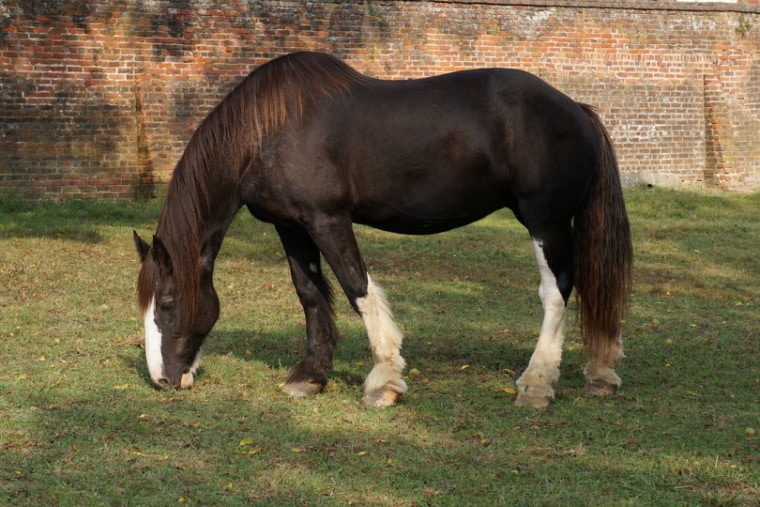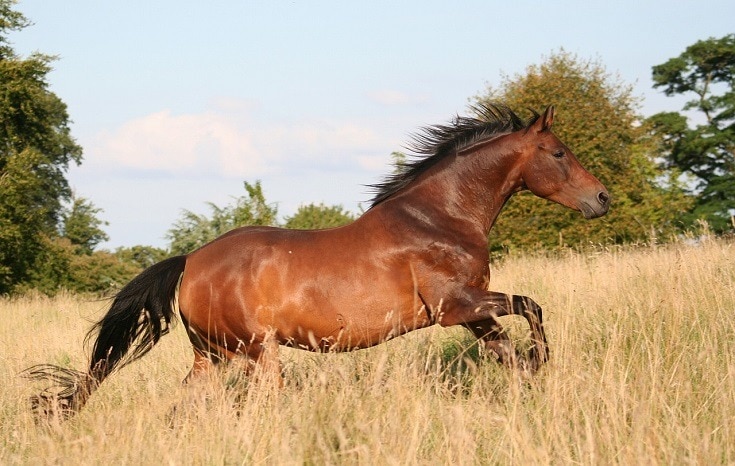
Click to Skip Ahead
The Mustang stands unique among horse breeds because of their history and status as a protected feral animal in the American West. These wild populations exist primarily on the US Bureau of Land Management (BLM) Herd Management Areas.1 Unlike many equines, there isn’t a domestic breeding program for Mustangs. Instead, the agency makes them available for adoption.
Owning a horse is a significant undertaking. It is even a greater challenge when dealing with a wild, untrained animal. However, with the right training, your Mustang will learn to trust you and become a loyal companion, whether on the job, in the show ring, or on the trail.
States with Mustang populations often selectively breed their horses for particular characteristics. That means you’ll see a broad spectrum of body conformations and temperaments.
Quick Facts about Mustangs
| Species Name: | Equus ferus caballus |
| Family: | Equidae |
| Care Level: | Varies with |
| Height: | 14-15 hands (56-60”) |
| Temperament: | Depends on the horse’s background |
| Colors: | Black, gray, chestnut, pinto, roan, bay |
| Lifespan: | Up to 40 years |
| Weight: | 800 lbs. |
| Human Interactions: | Ranch work, dressage, and trail riding |
| Facility and Shelter: | 5-6’H shelter with a 20’ x 20’ corral area |
| Diet: | Fresh or harvested hay forages |
| Trainability: | Fast learners, observant, intelligent |
Mustang Overview
The Spaniards brought the first domesticated horses to the United States in the 15th century. The feral populations existing today are descendants of those animals that were either released intentionally or unintentionally in the wild. This history means that today’s Mustangs are hardy horses, capable of handling the elements well. They are also surefooted.

Few animals have stirred up the controversies that the Mustang has. The habitats that the horses occupy often overlap those of livestock ranches. Inevitably, conflicts arise between the interests of those who want to preserve these wild populations and ranchers. Environmentalists point out that the horse is an introduced species and question their status. Supporters argue that they are part of the American heritage.
The federal government stepped in with the Wild and Free-Roaming Horses and Burros Act of 1971 to protect the wild Mustang and burro populations. However, the wrangling on all sides continues to this day.
How Much Do Mustangs Cost?
Unfortunately, the Mustang population has increased to unsustainable levels. That has led to more conflicts between those with competing interests. The BLM began an adoption program to try to get the numbers under control. To adopt an animal, you must meet specific requirements regarding your background, basic facility standards, and transport trailers.
Some of these requirements vary by state, often based on the environmental pressures that the Mustangs will likely face in some areas. You must complete an application form to proceed. The minimum cost is $25 for an untrained animal at lottery draw events. Otherwise, you’ll have to pay $125 for a gentled and trained Mustang.
Typical Behavior & Temperament
Horses are prey animals and exhibit behavior that displays this fact. So, remember that you’re dealing with an animal that lives by these protective instincts. Some Mustangs are easily spooked and others are more docile.
The best approach is to give your newly adopted Mustang time to work through the stress of transport and arrival at their new home. After the horse has acclimated to your routine, you can proceed with the process of gentling and training them. Keep in mind that their fight-or-flight insights are at the forefront until you and your horse bond.

Appearance & Varieties
Mustangs are a smaller, stocky breed, reaching 14-15 hands high. They can weigh up to 800 lbs. You’ll find them in a wide range of colors, from palomino to chestnut and black. There isn’t an official standard for the breed, so you’ll likely see variation between different horses.
The BLM manages off-range corral adoption and purchase centers across the country in 12 states. These localized populations will have Mustangs with genetic variations because of the isolated breeding populations.
How to Take Care of Mustangs
Facility and Shelter
The requirements via the BLM for a Mustang’s facility and shelter are an excellent place to start because it addresses the differences between untrained and trained animals. The agency recommends 400 square feet as the minimum size for a corral. You should have a facility that is at least 5 feet high for a trained horse or 6 feet high for an ungentled one.
The shelter can be natural cover or a manmade structure, depending on where you live. Areas that have more extreme weather conditions require something more substantial to protect your Mustang.
Pasture Plants
An integral part of raising any horse that you want to allow to graze is the quality and makeup of the pasture plants. Land that has a mix of legumes and grasses will ensure a well-rounded diet for your Mustang. The legumes will also improve the quality of the pasture. On the other hand, some plants and trees are potentially toxic to equines.

Trees to avoid include box elder, black walnut, and certain maple species if your horse eats too much of the foliage. Likewise, chokecherry and wild parsnip are also problematic.
Do Mustangs Get Along With Other Animals?
Like other horses, Mustangs are social animals. It may help with the acclimation process if other equines are nearby in separate corrals. We don’t recommend introducing your horse to the family dog right away, though. Remember that a stressed animal is a reactive one, especially with unfamiliar people and animals.
What to Feed Your Mustang
Mustangs graze on the shrubs and grasses of their habitat. You can let them graze in the pasture or provide harvested hay. Plan on offering them 2-2 ½ percent of their body weight per day. Bear in mind that these horses are opportunistic feeders. If you turn them loose in a well-planted pasture, they’ll likely gorge themselves. That’s the survival instinct at work but a sure path to obesity.
Make sure that fresh water is always available to your Mustang. They can drink up to 15 gallons a day. We suggest keeping a filled trough instead of a bucket because it’ll seem more like what they’re used to in the wild. You should also provide a mineral block to satisfy your horse’s needs for salt and electrolytes.
Keeping Your Mustang Healthy
If you adopt your Mustang from the BLM, the horse will have been vaccinated and dewormed by a licensed veterinarian. The agency also screens animals for Equine Infectious Anemia. The Mustang presents unique challenges when it comes to health care.
In the wild, the horse traverses on rugged terrain that keeps hoof growth in check. When you’re a horse owner, that becomes your job as part of their health maintenance. Fortunately, these animals typically have healthy hooves. The same advice applies to your Mustang’s teeth. Many vaccinations will also require annual boosters.
Breeding
While the BLM does the health screenings on your animal, pregnancy testing is not one of them. Bear that in mind if you adopt a mare, you may end up with more than you bargained for 12 months down the road.
Are Mustangs Suitable for You?
Mustangs are magnificent animals with a storied past. They are survivors that have endured harsh weather conditions, rugged terrains, and the looming presence of predators, such as mountain lions. All of these environmental pressures have shaped the evolution of these horses. They are not suitable for first-time horse owners.
Mustangs require a significant investment in time and effort because of their tumultuous history in the wild. It takes patience and dedication to forge the bonds of trust imperative for the horse’s well-being. The best owners have years of horse-rearing experience and understand fully the commitment that a Mustang requires.
Featured Image Credit: getamover, Pixabay









